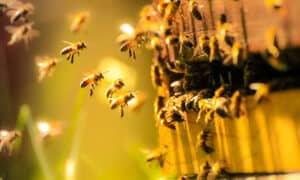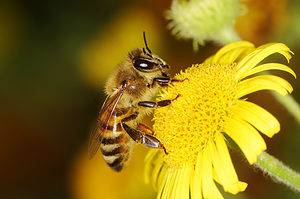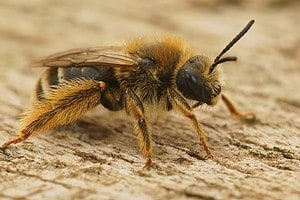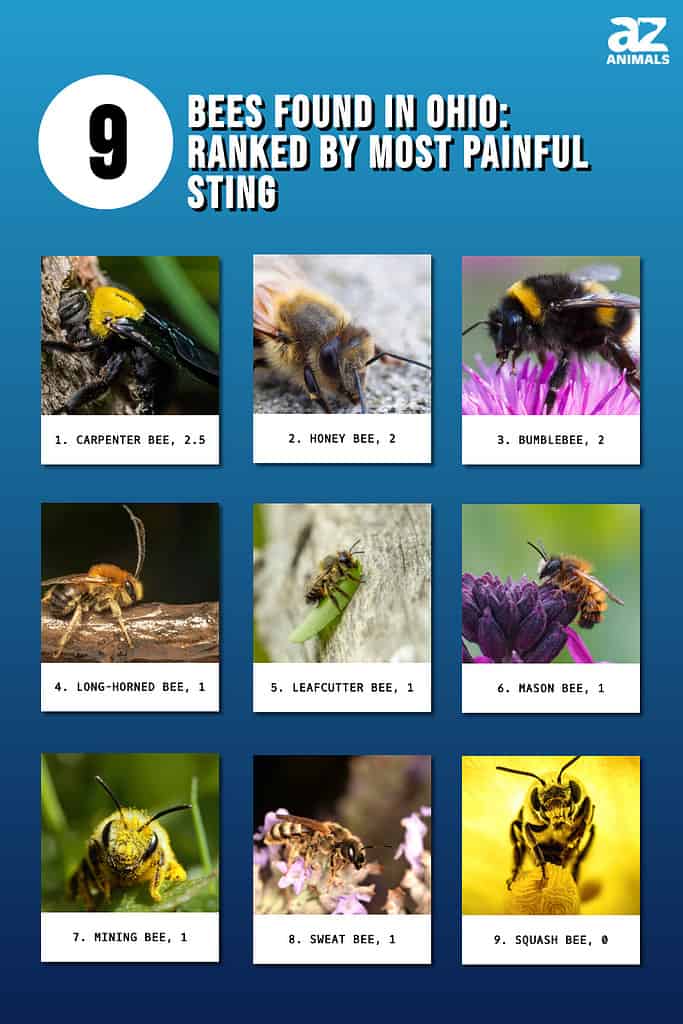
While Ohio is home to some 500 bee species, there is a small handful of bees Ohioans are most likely to encounter. According to Ohio State University, nine of the most common bees in Ohio are the:
- Bumblebee
- Carpenter Bee
- Honeybee
- Leafcutter bee
- Long-horned bee
- Mason bee
- Mining bee
- Squash bee
- Sweat bee
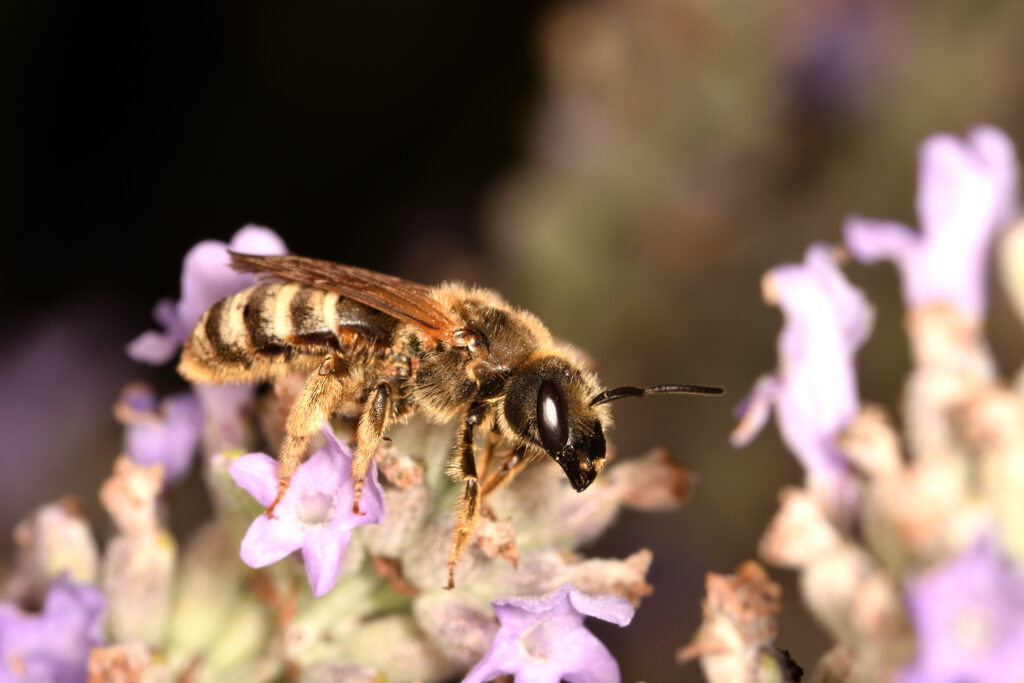
The sweat bee is a small bee that is commonly seen in Ohio.
©Davide Bonora/Shutterstock.com
Of these common Ohio bees, which ones pose the greatest risk of inflicting a painful sting? We can answer that question thanks to the work of one entomologist who came to be known as “The King of Sting.”
How Do We Know Which Stings Are Most Painful?
The next time you are tempted to complain about your job, imagine being stung for a living! Dr. Justin Schmidt was an entomologist at Carl Hayden Bee Research Center in Tuscon, Arizona. He developed a scale to rank the pain of stinging insects the only way he knew how: he allowed the insects to sting him.

Bee stings are never fun, but imagine being stung for a living! That was Dr. Schmidt’s job as he created the Schmidt Sting Pain Index.
©WIRACHAIPHOTO/Shutterstock.com
After being stung, he rated each insect’s sting on a pain scale of 1-4. Dr. Schmidt ranked 78 species of stinging insects from around the world on what has come to be known as the Schmidt Sting Pain Index. There will be no more additions to the list as Dr. Schmidt passed away in February 2023 at the age of 75 after battling Parkinson’s disease. His scientific curiosity led to a variety of discoveries in bee nutrition and insect defenses, but the pain index that bears his name is sure to be his most enduring entomological legacy.
In the study published by the National Library of Medicine, Schmidt described how the pain index was constructed. He wrote, “The scale ranges in values from 1-4 and is anchored by the value of a single honeybee sting, which is defined as a 2 on the scale. The honeybee is a convenient reference point because honeybees exist worldwide, are abundant, and most people have been stung by a honeybee.”
The Most Painful Sting
The most painful sting Dr. Schmidt experienced in his study did not come from a bee, but rather from the bullet ant of Central and South American rainforests. The ant received a score of 4+ on the scale, with Dr. Schmidt describing the result of the ant’s sting as, “Pure, intense, brilliant pain. Like walking over flaming charcoal with a three-inch rusty nail in your heel!” He noted that the pain inflicted by this ant’s venom is not only intense but also long-lasting. The pain from a single ant sting can throb relentlessly for up to three days.
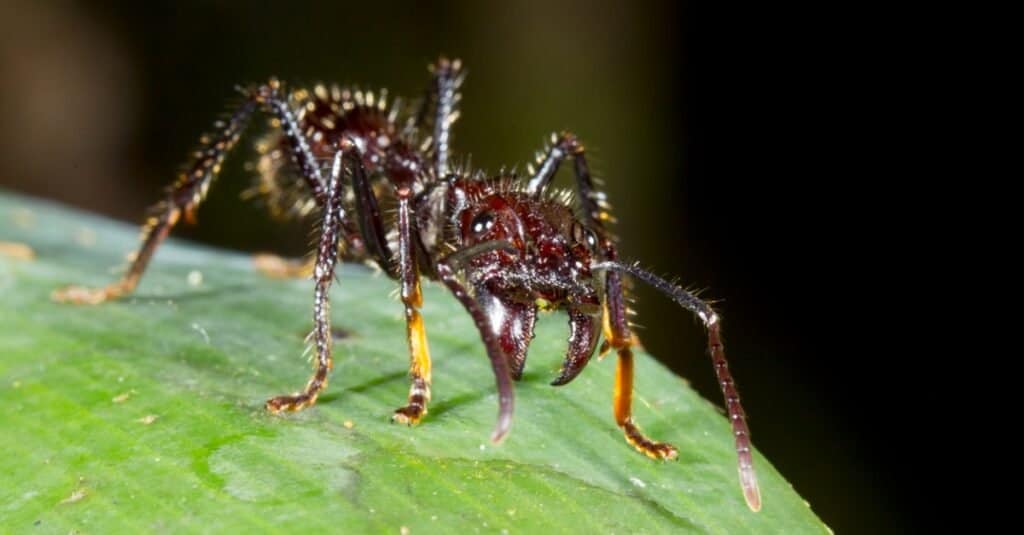
The bullet ant has the most painful sting recorded on the Schmidt Sting Pain Index.
©iStock.com/Atelopus
Where Do Ohio’s Common Bees Rank?
It should be a comfort for Ohioans to know that the stings of the Buckeye State’s most populous bees don’t rank anywhere near the pain inflicted by the bullet ant of Central and South America.
As stated above, the honeybee was used as the baseline to measure all other stings. While the honeybee sting is certainly not pleasant, its ranking of a 2 on the scale was the baseline that Dr. Schmidt used to measure all other stings (he estimated that he was stung over 1,000 times in his career!).
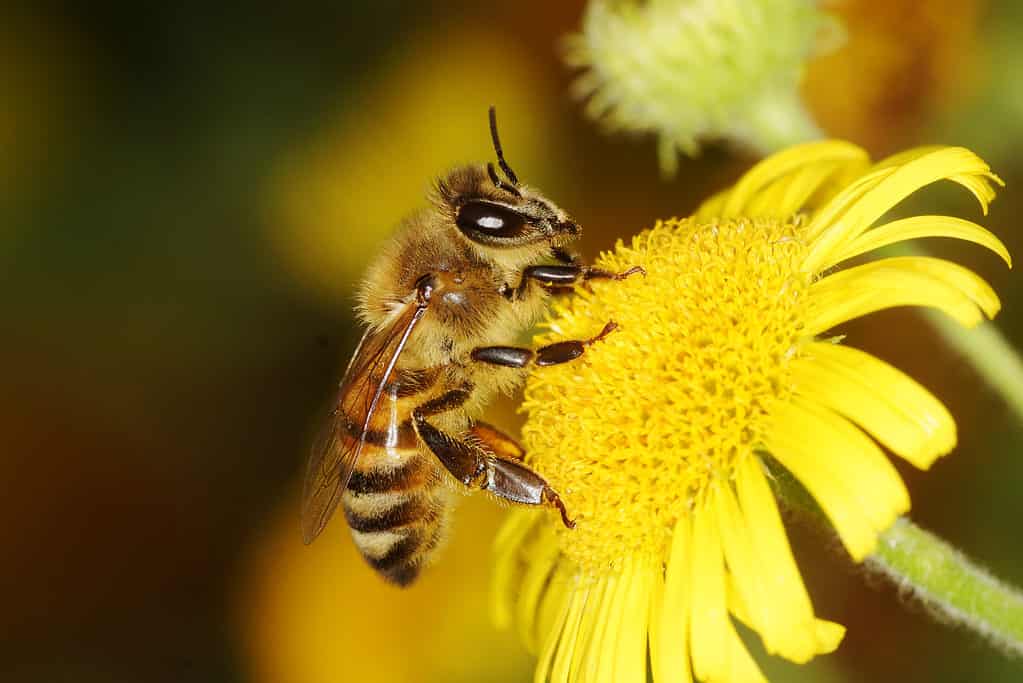
The honeybee’s sting was used as the baseline by which Dr. Schmidt measured all other stings.
©Maciej Olszewski/Shutterstock.com
Fun fact: if you have ever been stung by a bee, it was a female that perpetrated the act. The stinger (or sting) is a modified egg-laying device only possessed by females.
Most Painful Bee Sting In Ohio
The most painful bee sting of any of Ohio’s most common bees is the sting of the carpenter bee with a rating of 2.5 on the Schmidt Sting Pain Index. The good news is that carpenter bees are not overly aggressive. If you leave them alone, they will likely leave you alone. Their sting is usually secondary to the main concern these bees present, which is the potential damage they can do to wooden structures. The holes created by these bees are almost perfectly round, as if they were created with a power drill. The bees’ first choice for their nesting galleries is an old tree, but they will also bore into decks, picnic tables, swing sets, and even houses.
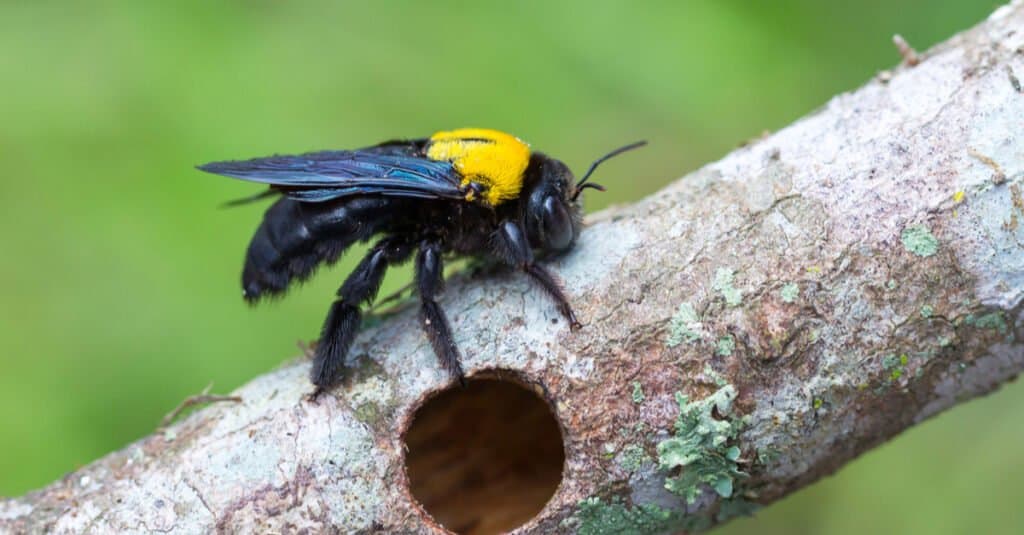
A perfectly round hole in a tree (or worse, in a home!) is a sign that carpenter bees are at work.
©Zety Akhzar/Shutterstock.com
Now that we know where the honey bee and carpenter bee rank on the Schmidt Sting Pain Index, how about the rest of Ohio’s common bees?
Other Common Ohio “Stingers”
- Bumble Bee – 2
Bumblebees usually sting only when they are cornered or their hive is disturbed. Unlike a honeybee, the bumblebee’s stinger is not barbed and does not detach after one sting. While a bumblebee sting is comparable to the pain of a honeybee sting, the bumblebee can sting multiple times whereas a honeybee can sting only once. - Leafcutter Bee – 1
These bees are not aggressive and typically only sting when they are handled. The sting is significantly lighter and less painful than a honeybee sting. - Long-horned Bee – 2
These bees are not aggressive, but their sting does pack a bit of a punch. The bigger danger may be that yellowjackets can be mistaken for the more passive long-horned bee. The sting of a yellowjacket (which is a wasp, not a bee) is more painful and long-lasting than that of a long-horned bee. - Mason Bee – 1
Mason bees can sting, but it is very rare. They will buzz close to humans, sometimes even landing on them, but with no desire to sting. If a rare sting does happen, it causes minimal discomfort. - Mining Bee – 1
Mining bees are not aggressive. If they do sting, these tiny bees can barely penetrate the skin. - Squash Bee – 0
Squash bees do not have stingers, so they receive a “0” on the pain scale. - Sweat Bee – 1
The sweat bee was among the lightest of stings recorded by Dr. Schmidt in his entire worldwide study. Schmidt described its sting as, “Light and ephemeral. Almost fruity. A tiny spark has singed a single hair on your arm.”
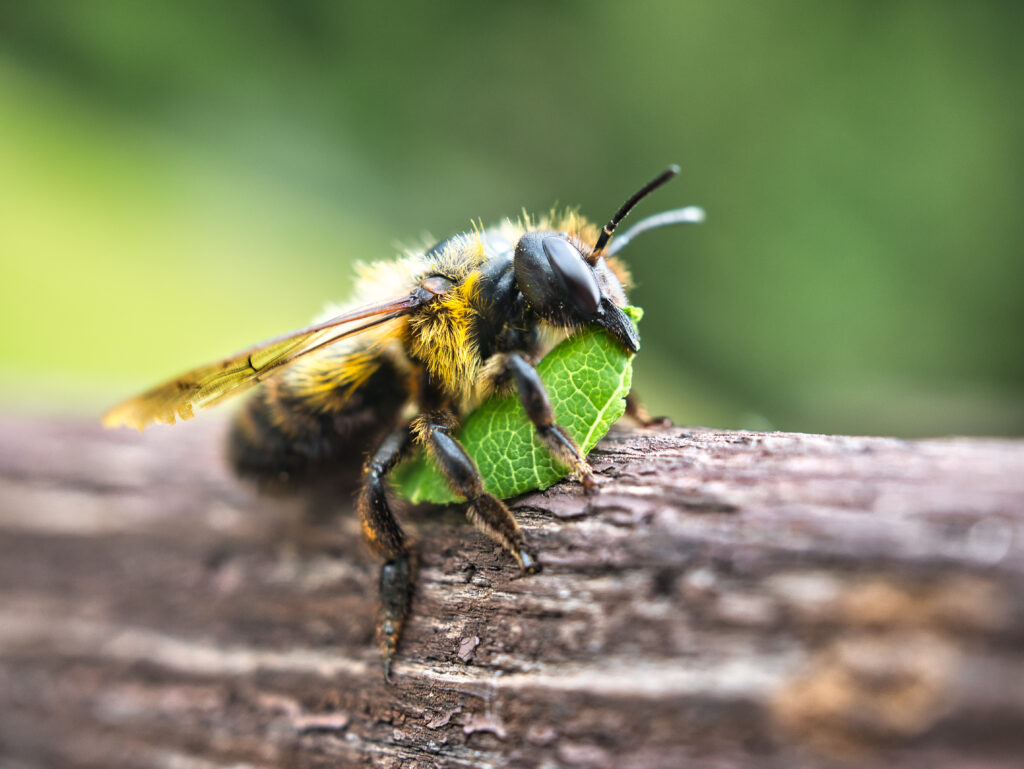
Leafcutter bees are not aggressive and feature a relatively light sting.
©Maurice Lesca/Shutterstock.com
Are Killer Bees In Ohio?
When the subject of bees arises, it is easy to think of the horror stories you may have heard about the Africanized bee, also known as the killer bee. This hybrid of the honey bee is one of the most aggressive insects in the world.
The danger of these bees is not necessarily found in the pain of one sting as would be ranked on the Schmidt Pain Index, but rather in the great numbers of guard bees in a colony. The guard bees are highly aggressive if the hive is disturbed and will chase intruders up to a quarter-mile from the hive.
But are these hyper-aggressive bees found in Ohio? They are rare, but Africanized bees have been documented in the state.
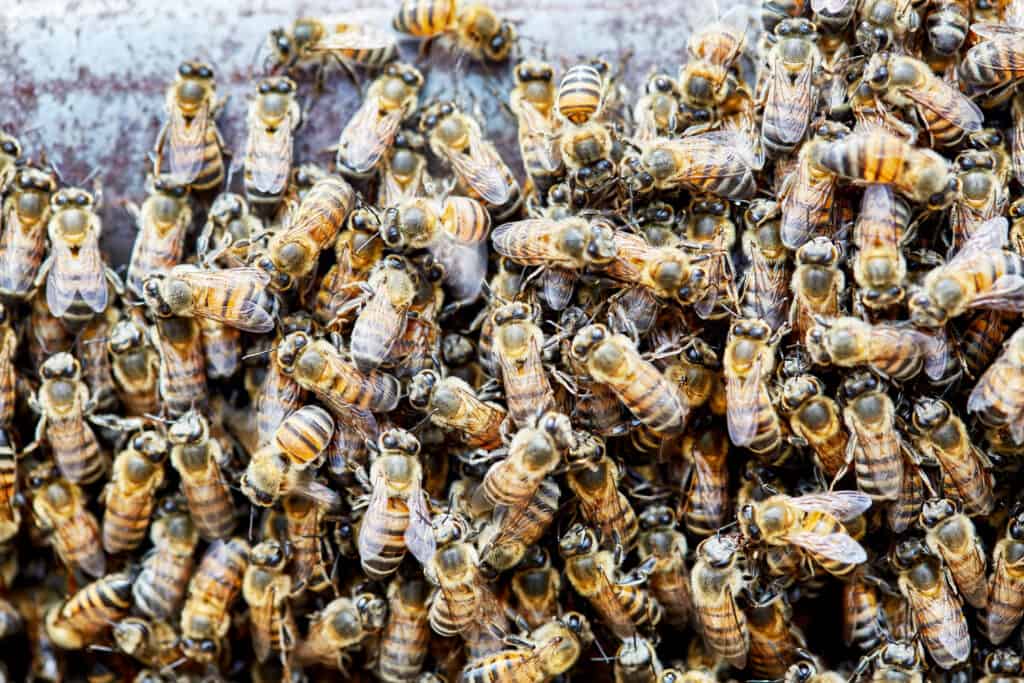
While not common, Africanized bees have been documented in Ohio.
©Pamela Au/Shutterstock.com
In September 2022, an Ohio man was trimming a tree when he inadvertently cut into a beehive. He was stung 20,000 times by what was determined to be Africanized bees. The incident occurred in Ripley, a small town in Brown County, Ohio. Austin Bellamy was transported via helicopter to the University of Cincinnati Medical Center. Remarkably, he survived the harrowing ordeal.
Again, the odds of Ohioans encountering Africanized bees are very low, but obviously, the odds are not zero.
Allergies
The stings of Ohio’s common bees are a minor inconvenience for most people. However, serious allergic reactions are a possibility for some and should be taken seriously. Remember, the Schmidt Pain Index does not consider allergic reactions to the stings of bees or any other insect.
Summary Of The 9 Bees Found In Ohio: Ranked By Most Painful Sting
| Rank | Bee | Pain Score |
|---|---|---|
| 9 | Squash bee | 0 |
| 8 | Sweat bee | 1 |
| 7 | Mining bee | 1 |
| 6 | Mason bee | 1 |
| 5 | Leafcutter bee | 1 |
| 4 | Long-horned bee | 2 |
| 3 | Bumblebee | 2 |
| 2 | Honey Bee | 2 |
| 1 | Carpenter Bee | 2.5 |
The photo featured at the top of this post is © Gerry Bishop/Shutterstock.com
Thank you for reading! Have some feedback for us? Contact the AZ Animals editorial team.



